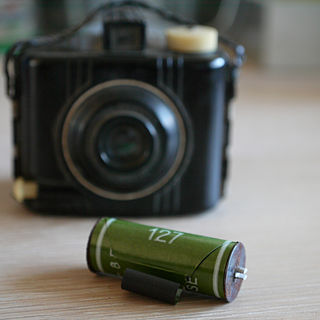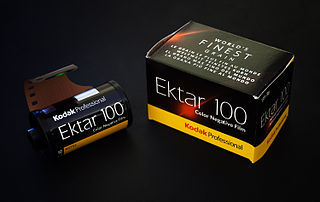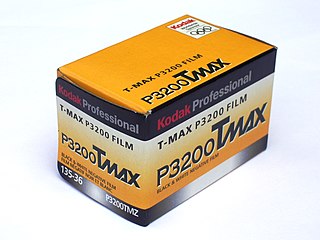 W
W120 is a film format for still photography introduced by Kodak for their Brownie No. 2 in 1901. It was originally intended for amateur photography but was later superseded in this role by 135 film. 120 film and its close relative, 220 film, survive to this day as the only medium format films that are readily available to both professionals and amateur enthusiasts. As of December 2018 all production of 220 film has stopped/paused worldwide. The only remaining stocks are from the last Fujifilm production run (2018) and they are mostly found in Japan.
 W
W126 film is a cartridge-based film format used in still photography. It was introduced by Kodak in 1963, and is associated mainly with low-end point-and-shoot cameras, particularly Kodak's own Instamatic series of cameras.
 W
W127 is a roll film format for still photography introduced by Kodak in 1912.
 W
W135 film, better known as 35 mm film, is a format of photographic film used for still photography. It is a cartridge film with a film gauge of 35 mm (1.4 in), typically used for hand-held photography in 35 mm film cameras. Its engineering standard for the film is controlled by ISO 1007.
 W
WDisc film is a discontinued still-photography film format that was aimed at the consumer market. It was introduced by Kodak in 1982.
 W
WEktachrome is a brand name owned by Kodak for a range of transparency, still, and motion picture films previously available in many formats, including 35 mm and sheet sizes to 11×14 inch size. Ektachrome has a distinctive look that became familiar to many readers of National Geographic, which used it extensively for color photographs for decades in settings where Kodachrome was too slow. In terms of reciprocity characteristics Ektachrome is stable at shutter speeds between ten seconds and 1/10,000 of a second.
 W
WKodak Ektar is a professional color negative film introduced in 2008, designed for nature, outdoors, fashion, and product photography. The film offers ultra-fine grains, ultra-vivid colors, and high saturation, and is available in ISO 100 only.
 W
WEktachrome is a brand name owned by Kodak for a range of transparency, still, and motion picture films previously available in many formats, including 35 mm and sheet sizes to 11×14 inch size. Ektachrome has a distinctive look that became familiar to many readers of National Geographic, which used it extensively for color photographs for decades in settings where Kodachrome was too slow. In terms of reciprocity characteristics Ektachrome is stable at shutter speeds between ten seconds and 1/10,000 of a second.
 W
WKodak High-Speed Infrared film, also known as Kodak HIE, was a popular black-and-white infrared photographic film from Kodak. The film was sensitive to the visible light spectrum, infrared radiation up to 900nm in wavelength, and some ultraviolet radiation as well.
 W
WKodachrome is the brand name for a color reversal film introduced by Eastman Kodak in 1935. It was one of the first successful color materials and was used for both cinematography and still photography. For many years Kodachrome was widely used for professional color photography, especially for images intended for publication in print media. Because of its complex processing requirements, the film was sold process-paid in the United States until 1954, when a legal ruling prohibited that. However, the arrangement continued in other markets.
 W
WIn still photography, Kodak's Kodacolor brand has been associated with various color negative films since 1942. Kodak claims that Kodacolor was "the world's first true color negative film". More accurately, it was the first color negative film intended for making paper prints: in 1939, Agfa had introduced a 35 mm Agfacolor negative film for use by the German motion picture industry, in which the negative was used only for making positive projection prints on 35 mm film. There have been several varieties of Kodacolor negative film, including Kodacolor-X, Kodacolor VR and Kodacolor Gold.
 W
WAdvanced Photo System (APS) is a discontinued film format for still photography first produced in 1996. It was marketed by Eastman Kodak under the brand name Advantix, by FujiFilm under the name Nexia, by Agfa under the name Futura and by Konica as Centuria.
 W
WThe following is a partial list of products manufactured by Kodak.
 W
WKodak Portra is a family of daylight-balanced professional color negative films originally introduced in 1998 made mainly for portrait and wedding applications. They are successors of the professional Vericolor films, which succeeded Ektacolor films earlier. The films are available in three speeds — 160, 400, and 800 ISO — with the 160 and 400 speed formerly available as "natural color" (NC) and "vivid color" (VC) varieties before the 2011 update.
 W
WThe following is a partial list of products manufactured by Kodak.
 W
WTechnical Pan is an almost panchromatic black-and-white film that was produced by Kodak. While it can reproduce the visible light spectrum, it leans to the red, and so unfiltered outdoor shots render blues, most notably the sky, with additional darkening and reds with some lightening. It was generally used as a very slow film, rated at EI 25 or even 16, although it could be rated at up to EI 320 with a distinct loss of tonal range and a bunching of shadow and highlight detail. This film has unmatched fine grain, especially when rated at a low speed, and makes excellent enlargements while preserving fine details. Kodak stopped selling it in 2004. It has not been replaced by a film with its characteristics.
 W
WKodak Professional T-MAX Film is a continuous tone, panchromatic, tabular-grain black and white negative film originally developed and manufactured by Eastman Kodak since 1986. It is now manufactured by Eastman Kodak but distributed and marketed by Kodak Alaris.
 W
WTri-X is a black and white photographic film produced by Eastman Kodak Company, and distributed by Kodak Alaris. The combination of hand held cameras and high speed Tri-X film was transformative for photojournalism and for cinema.